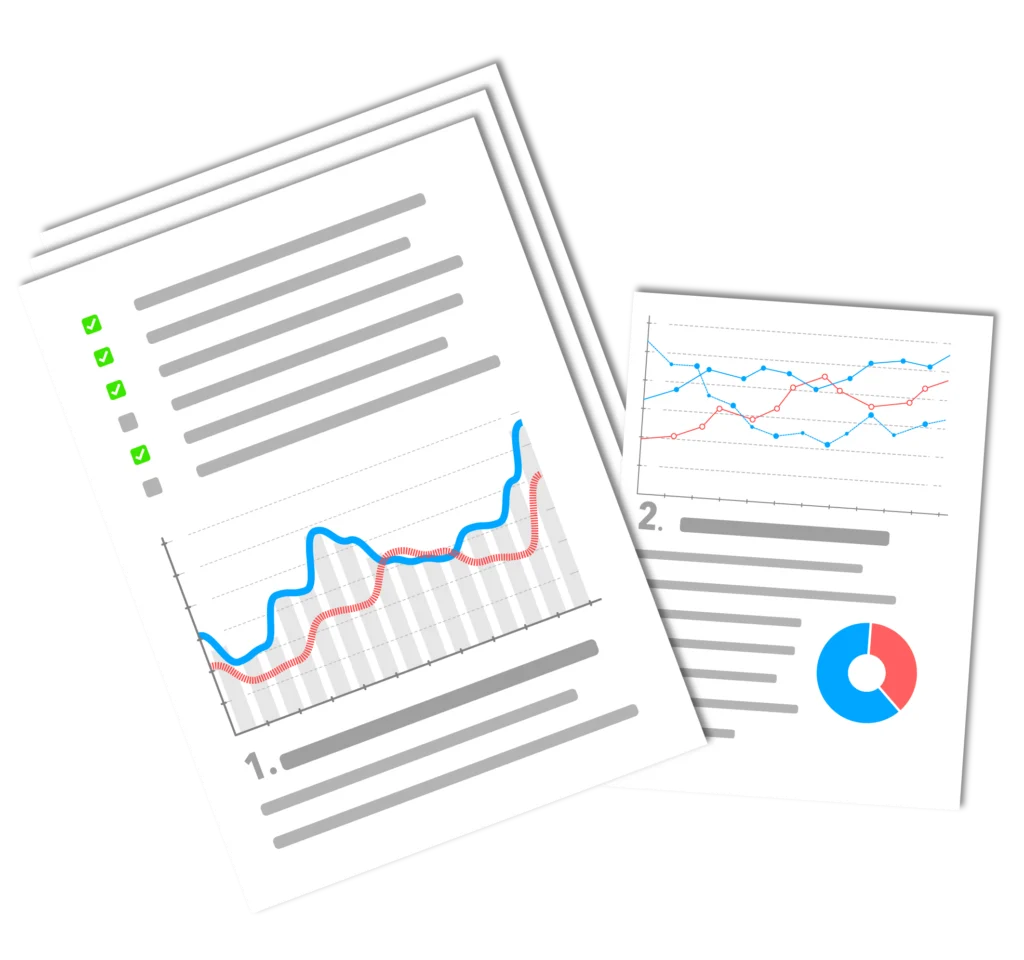URLs für SEO sind ein wichtiges Element, das sich positiv auf deine Platzierungen auswirken wird. Wenn du es richtig machst. Best Practices im SEO wird meistens nur auf Schwerpunkte wie die Verwendung der wichtigsten Keywords auf deiner Website, z. B. in Meta-Beschreibungen, Titel-Tags, Alt-Text von Bildern und Seitentexten gelegt. Angesichts der Tatsache, dass jeden Tag mehr als 3,5 Milliarden Suchanfragen bei Google durchgeführt werden, ist es für die und deine Website extrem wichtig es Google so einfach wie möglich zu machen deine Website zu verstehen und einzukategorisieren.
The use of a strong and clear URL-Struktur könnte dir helfen besser als deine Konkurrenzen platziert zu werden.
Nachfolgenden erklären wir dir, wie du deine URL-Struktur auf das nächste Level bringst.
Why are clean URL structures so important in SEO?
URLs sind ein wesentliches Element im SEO-Bereich, das oft unterschätzt wird. Hier sind die Hauptgründe, warum eine gut strukturierte URL is so important:
Keyword relevance
The inclusion of keywords in the URL can improve the visibility of a website in search results. Keywords in the URL help search engines better understand the content of the page. But be careful: Keyword-Stuffing sollte vermieden werden, um nicht als Spam eingestuft zu werden.
User experience
A clear and easy to understand URL hilft dem Benutzer, den Inhalt der Seite bereits vor dem Klicken zu erkennen. Dies verbessert nicht nur die Benutzererfahrung, sondern erhöht auch die Wahrscheinlichkeit, dass der Benutzer die Seite tatsächlich besucht.
Crawling and indexing
Search engine crawlers have an easier time finding a cleanly structured URL zu indexieren. Dies ist besonders bei großen und komplexen Websites wichtig, bei denen die effiziente Indexierung durch die Suchmaschinen eine große Rolle spielt.
Confidence building
A clear and logical URL-Struktur wirkt professioneller und vertrauenswürdiger. Unklare oder irreführende URLs können Benutzer abschrecken, selbst wenn der Inhalt der Seite hochwertig ist.
Easier linking
Eine prägnante und beschreibende URL ist viel einfacher zu teilen – sowohl online als auch offline. Dies erhöht die Chance auf Backlinks and social shares, which can have a positive impact on SEO.
Alles in allem sind URLs mehr als nur Adressen für Webseiten; sie sind ein Instrument, das, wenn richtig eingesetzt, die Sichtbarkeit und Benutzererfahrung erheblich verbessern kann. Daher ist es ratsam, bereits in der Planungsphase einer Website der URL-structure to pay appropriate attention.
Match SEO URLs with page titles
The connection between your URL und deinem Seitentitel kann deine Platzierung in den Suchmaschinen verbessern. Eine Möglichkeit, das zu erreichen, ist, die URL-structure to the page title. Compare afterwards the pages with this practice and without it.
Nehmen wir an, dein Seitentitel lautet “reich werden mit Krypto“. Wenn ein Nutzer eine Google-Suche durchführt und sich zu deiner Seite durchklickt, wird erwartet, dass die URL dieser Seite mit dem Seitentitel übereinstimmt – und der Seiteninhalt mit beiden.
Das hilft nicht nur den Suchmaschinen, deine Seite zu indexieren, sondern schafft auch Vertrauen und Autorität bei deinem Publikum. Deine URL should then look something like this.
Page title: Get rich with crypto
The SEO friendly URL:
https://www.domain.com/reich-werden-mit-krypto
Remove unnecessary words
If you have a good SEO URL-Struktur einhalten möchtest, solltest du darauf achten, deine URLs möglichst kurz zu halten.
Go with the URL Struktur niemals mehr als vier Sub-Folder tief. Vermeide Füllwörter, Zahlen und Symbole, die nicht zu deinen Keywords passen. Verwende stattdessen kurze Wörter, die direkt zu deinen Keywords passen. Unterstreiche wichtige Wörter, um deine URL zu verstärken und vermeide Umlaute, die in URLs nicht gut funktionieren.
Your URLs should address two audiences: Google and its users. If the topic of your page is not quickly identified by a look at the URL zu verstehen ist, ist sie nicht für SEO optimiert. Wörter, die keinen Sinn ergeben, gelten als überflüssig und können entfernt werden. Das Website-Optimierungsunternehmen Yoast hat in seiner Wissensdatenbank eine Liste von Stopp-Wörtern zusammengestellt, die zu den häufigsten Wörtern der deutschen Sprache gehören. Die Liste enthält Wörter wie „und“ und alle möglichen Artikel.
An example of a URL, die Stoppwörter enthält, wäre:
https://www.domain.com/wie-man-seine-url-struktur-für-seo-optimiert
The same URL, die für SEO optimiert wurde, indem Stoppwörter entfernt wurden, lautet:
https://www.domain.com/seo-url-optimize-structure
Avoid punctuation
Like stop words, punctuation marks can also be regarded as non-essential characters. But they deserve to be explained in a separate section. With the advent of Content-Marketing practices and companies that invest heavily in developing helpful resources to answer common questions, your page title could be a question. Or it could contain commas, parentheses, quotation marks, etc.
While punctuation is perfectly fine in SEO elements like title tags and meta descriptions, you shouldn't use it in your URLs. They only cause confusion for search engines and distraction for users, which will have a negative impact on your search engine ranking.
Use hyphens
Unterbrich beschreibende Wörter innerhalb deiner URL, um die Lesbarkeit für Nutzer und Suchmaschinen zu verbessern. In der SEO-Community wird immer wieder über Bindestriche und Unterstriche diskutiert und darüber, welches Format Google bevorzugt. Interessanterweise behandelt Google Bindestriche und Unterstriche bei der Indexierung von URLs nicht gleich. Bindestriche gelten als Worttrenner, die die Lesbarkeit der URL verbessern, während Unterstriche als Wortverbinder behandelt werden.
Example:
https://www.domain.com/seo-optmierte-url-structure
Würde Google als „SEO optmierte URL-Struktur“ lesen.
https://www.domain.com/seo_optmierte_url_structure
Would read Google as "seooptmierteurlstruktur".
Google liest also Bindestriche leichter und ist damit auf für deine URL-Structure advantageous
Avoid dynamic parameters for SEO URL structures
A dynamic URL ist eine „URL, which results from the search of a database-driven website or the URL of a website that executes a script." They often contain characters such as ?, &, %, +, =, $, cgi-bin, .cgi and are limited to E-commerce-sides usual.
Wann immer es möglich ist, solltest du URLs mit dynamischen Parametern vermeiden, da Suchmaschinen statische, SEO friendly URLs mit einer logischen Struktur und beschreibenden Schlüsselwörtern bevorzugen.
When your Content-management system automatically creates URLs with dynamic parameters, you can use a link shortening tool.Plugin mehr Kontrolle über die Erstellung deine URL und damit über die verschiedenen Parameter bringen.
With a link shortening tool you can for example:
https://www.domain/xyzproduct/i?HAPL=u#abc43567q
to nike.sneakers/running.
Avoid subfolders
Deine URLs sollten so einfach und so kurz wie möglich sein. URLs enthalten oft viele Unterordner und diese Struktur kann es Suchmaschinen erschweren, deine Seite zu crawlen. Um SEO-freundliche URLs zu erstellen, halte sie sauber, indem du die Verwendung von Unterordnern einschränkst.
A URL mit Unterordnern könnte lauten:
https://www.domain.com/2017/11/09/wie-kann-ich-kryptowährungen-kaufen
With an SEO-friendly URL würden die Unterordner wie folgt entfernt:
https://www.domain.com/wie-kann-ich-kryptowährungen-kaufen
Go with the URL Struktur niemals mehr als vier Sub-Folder tief. Vermeide Füllwörter, Zahlen und Symbole, die nicht zu deinen Keywords passen. Verwende stattdessen kurze Wörter, die direkt zu deinen Keywords passen. Unterstreiche wichtige Wörter, um deine URL zu verstärken und vermeide Umlaute, die in URLs nicht gut funktionieren.
Limit your redirects
If you use too many redirects to your website, it can cause your website to slow down. Slower websites usually have a higher bounce rate. A high bounce rate is a sign to Google that users don't like your website.
For the search engines, it may be that the redirects are not tracked correctly (or not at all). This means that these Ranking-signals may not be taken into account.
Vermeide das Risiko und schränke Weiterleitungen ein, wenn es möglich ist. Wenn es unbedingt nötig ist, verwende eine 301-Weiterleitung für eine dauerhafte Weiterleitung, die zwischen 90 und 99 % des Link-Juice an die weitergeleitete Seite weitergibt.
A 301 Redirect is a quick and easy way to redirect old URLs to new pages. To ensure that the old URL auf die neue Seite weitergeleitet wird, musst du das richtige Code-Framework verwenden. Dafür kannst du z.B. ein Plugin on your website.
There are also a few other ways to redirect old URLs to new pages. Whatever you decide, it's important that you have the shortest possible redirect chains.
Use a descriptive domain
Domains are composed of three parts:
- Top-level domain (TLD)
- Domain name
- Optional Subdomain
Using a descriptive domain that is relevant to your business and contains your most important keywords will improve readability for users.
The simpler a domain or URL für Menschen zu lesen ist, desto besser ist sie für Suchmaschinen, da Suchmaschinen zunehmend auf Zugänglichkeit und Benutzerfreundlichkeit als Rankingfaktor setzen.
So, a rule of thumb for creating SEO URLs would be to use a descriptive, memorable domain that can be easily read by both users and search engines.
Shorter is better
Ein Schlüsselelement einer optimierten URL is the readability. The goal is to create a URL so zu strukturieren, dass sie von Suchmaschinen leicht indiziert werden kann und standardmäßig die Platzierung in den Suchmaschinen verbessert. Langatmige, komplexe URLs sollten vermieden werden.
Develop instead a URL-Struktur für deine Website, die dem Grundsatz „kürzer ist besser“ folgt.
Avoid URLs like this:
https://www.domain.com/diese-kryptowährungen-werden-imjahr-2023-durch-die-decke-gehen-und-dir-hohe-gewinnen-bringen
Instead, write the above link in an SEO-friendly URL like these around:
https://www.domain.com/besten-kryptowährungen-2023
Use lowercase letters and standard characters
SEO-friendly URLs support Google's readability guidelines. Therefore, creating URLs that use lowercase letters and standard characters is a best practice to improve search engine rankings.
Großbuchstaben gemischt mit Kleinbuchstaben können eine URL unübersichtlich machen. Diese Struktur verwirrt außerdem Suchmaschinen und Nutzer, daher solltest du sie unbedingt vermeiden.
Common non-standard characters in URLs are those we see in dynamic URLs, such as %, &, #, @. Some Content-Management systems also insert non-standard characters into document files such as PDFs. So make sure you check the structure before you share your links.
Avoid URLs like this:
https://www.domain.com/beste%-methode&-für%-SEO-freundliche-URL-Structures?
Write instead the above URL as follows:
https://www.domain.com/beste-seo-url-strcture
Buy short domains that contain keywords
Domains are important when it comes to SEO, even if they are not as important as they used to be, so you don't need to throw your domain away. You should keep this tip in mind for future websites.
Domains that are short and have an important Keyword for your business rank better. People often link to your website by linking their name - if you are a Keyword in your domain name will help you rank for it.
Another SEO factor that Google pays attention to when competitors are neck and neck is brand queries. If the name of your website is a frequently searched keyword, this will have a positive effect on your position.
What should be considered when URL structures change?
Die Änderung der URL-Struktur einer bestehenden Website ist so, als würdest du während einer Party die Zimmernummern ändern, während die Gäste schon da sind. Verwirrung ist vorprogrammiert, und du könntest ein paar Gäste verlieren – oder in deinem Fall Traffic, Ranking and ultimately also turnover. So, what should you bear in mind when taking this big step?
Planning is the key
Bevor du auch nur einen Finger rührst, solltest du dir Gedanken darüber machen, warum du die URL-Struktur ändern willst und welche Verbesserungen du dir davon erhoffst. Sprich: Macht es Sinn in Bezug auf Usability, Crawling and the Keyword-Strategy?
Create backup
It's like a safety net at the circus. Before you make any changes, make a full backup of your website. If something goes wrong, you can restore everything quickly.
Set up 301 redirects
Die wichtigste Regel überhaupt: Verliere keine Gäste! Mit 301-Weiterleitungen sagst du den Suchmaschinen, dass die alte URL now points to the new one. That helps Ranking and direct confused visitors to the right page.
Update internal links
Stell dir vor, du findest in einem Einkaufszentrum endlich deinen Lieblingsladen und der ist dann geschlossen. Genauso fühlt es sich für den User an, wenn interne Links ins Leere laufen. Also, aktualisiere deine internen Links, damit sie zur neuen URL-structure fit.
Update sitemap
Yours Sitemap is like the table of contents of your book. After restructuring, you need to bring it up to date. Download the updated Sitemap dann in der Google Search Console und anderen Webmaster-Tools high.
Monitoring and adaptation
After the changes are live, you should keep an eye on the performance. Use tools like Google Analytics and the Search Console to check the Traffic and the Ranking to monitor. If you notice that certain pages are experiencing a slump, it is important to react quickly.
So, restructuring URLs is definitely not a kid's birthday party, but with the right plan and tools, it becomes more of a treat than a nightmare. But remember, if you're going to URL-Struktur änderst, mach es richtig. Sonst könnte die Party ganz schön ins Wasser fallen.
Conclusion on SEO URL structures
Abschließend lässt sich festhalten, dass die URL-structure is an important element of SEO. A good URL-Struktur ist ein wesentlicher Bestandteil für eine erfolgreiche Suchmaschinenoptimierung. Sie unterstützt den Suchmaschinen-Crawler bei der Indexierung und helfen dabei, die Seite auf Google leichter zu finden. Wenn man eine URL strukturiert und sie visuell ansprechend gestaltet, kann man dazu beitragen, dass die Seite besser bewertet wird. Zudem erhöht man die Klickrate in den SERPs, was dazu führt, dass die Seite leichter gefunden wird.
- Avoid special characters. Avoid symbols and special characters that appear in the URL-link will appear. This can hinder search engine optimization and should therefore be avoided.
- Use relevant keywords. Try to include relevant keywords in your URL zu verwenden. Suchmaschinen können so besser herausfinden, worum es auf deiner Seite geht.
- Pay attention to the structure. Vermeide unnötig lange URLs und versuche, sie einfach und selbsterklärend zu halten. Auch die Struktur der URL should be clear and meaningful.
- Eliminate stop words. Wenn es möglich ist, solltest du sogenannte Stoppwörter wie „und“, „die“ oder „mit“ aus deiner URL entfernen. Dadurch wird sie kürzer und kann schneller verstanden werden.
- Use Lower case letters. Verwende keine Großbuchstaben in deiner URL, da die meisten Suchmaschinen dies nicht unterstützen. Verwende nur Kleinbuchstaben, um Probleme zu vermeiden.
The future prospects with regard to the URL-structure are also promising. The search engines are getting better at indexing pages that have a URL-Struktur haben, die als logisch und nützlich erachtet wird. Deshalb ist es wichtig, die URL-Struktur kontinuierlich zu überwachen und zu optimieren, um die SEO-Leistung zu verbessern.


